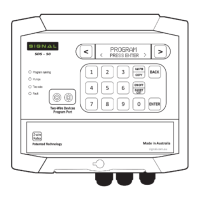SDS Series
54
Fault Finding
This fault finding operation requires a clamp-on milliamp meter with a range down to 20
milliamps and a SIGNAL two-wire fault finding tool (SD-RB). If this is not available, in an
emergency, a suitable 5-10 watt 250 Ohm wire wound resister can be connected in series
with the two-wire cable. Use caution and due care, as a resistor can reach temperatures that
will cause skin burn and melt plastics when in contact.
A malfunction of the system is evident when the red LED indicator is on. Press the ENTER key
to display the fault. In this instance we are describing the detection of a short circuit fault.
1. The DataCoil models SD2NC / SDSD3NO & SD3LT have, as a precaution, an internal
device that will short-circuit if excessive voltage is present. This reduces a “daisy chain”
effect of electrical surge damage to multiple DataCoils and other two-wire devices in the
event of a lightning strike.
2. When a short-circuit is present the electrical current load on the two-wire cable must be
reduced to a level where the circuit breakers do not reset, thus enabling electrical cur-
rent testing of the system.
The electrically short circuited device must be located and replaced or if a cable short, re-
paired and tested. If a TW device is not immediately available, disconnect the shorted device
from the two-wire cable until it can be replaced.
TRACING THE SOURCE OF AN ELECTRICAL SHORT CIRCUIT:
Connect the two-wire cable to the SIGNAL two-wire fault finding tool (SD-RB) to reduce the
current within the cable network. At the controller, access the TWO-WIRE menu, then navi-
gate to Run Valves and activate a valve to run for a suitable period of time. This will power-
up the cable network for fault detection.
A suitable low current reading clamp meter is used to trace the source of the short circuit. To
detect the high electrical current source, clamp the meter over one wire only, at a conven-
ient location normally at the valves where the inner insulated wires can be accessed. Any “T”
branches of the cable network should also be tested to follow the high current and hence the
short-circuit.
When tracing a short circuit, the clamp meter will indicate a higher current flow before the
short circuit. If the meter displays no or low current flow, you have bypassed the short. Once
zeroed into the suspected short-circuit location, clamp the meter on one of the wires between
the device and the two-wire cable to confirm this is the faulty device. In some instances, the
short-circuit could be in the two-wire cable. A cable fault is usually isolated to an area be-
tween two valves.
Refer to the examples on the following pages:
SHORT CIRCUIT FAULT FINDING OF TWO-WIRE DEVICES:

